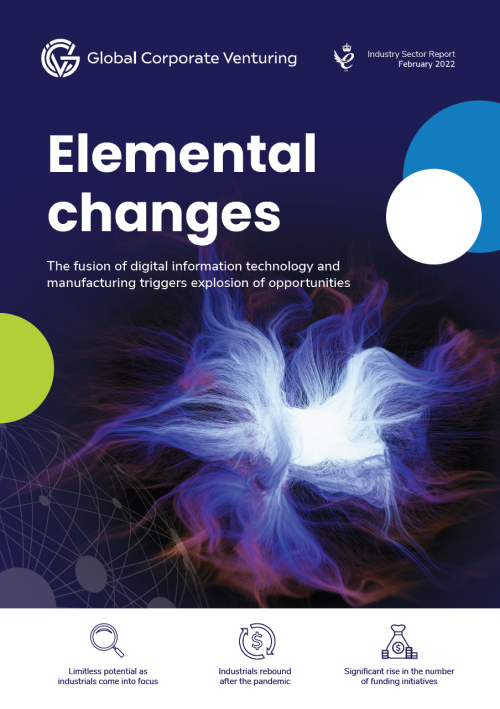Industry Q1 2022 editorial by James Mawson, editor in chief, Global Corporate Venturing
Two transformation-related themes – smart digitisation and environmental, social and governance (ESG) goals – run through Kaloyan Andonov’s report on the industrials corporate venturing landscape over the past year.
Perhaps the most exciting of all are the fundamental insights being gathered about the matter all around us, from the weight of the most elusive and mysterious of subatomic particles, the neutrino, to using computers to design new combinations of advanced materials.
ResearchAndMarket.com said there were many “futuristic opportunities in the advanced materials like nanomaterials, colloids, catalysts, etc”.
Take just one potential application: nuclear fusion. Scientists have long struggled to control the 150 million degrees temperature of plasma in fusion reactors. Today, Google’s DeepMind subsidiary is using deep reinforcement learning simulations to control two ‘blobs’ of plasma to their physical limit for the materials inside the tokamak reactor.
In a post for Exponential View, Ramsay Brown said this suggests the control problem is solved. “In some sense, the challenge of fusion is now a material science problem. Can we build containment units from materials that last as long as our machine-learning control systems can handle the hot plasma for us?”
Age of discovery
Of course, machine learning will help in the discovery of new materials. A group at the University of Liverpool found four new materials last year, while US-based startup Mat3ra, formerly known as Exabyte.io, raised $3m in its seed round for an AI-based platform that helps companies and researchers, including Merck KGaA-owned Intermolecular, the Air Force Research Laboratory and the Tokyo University of Science, model new materials at the atomic level.
But there is also excitement around creation of synthetic minerals facing increasing demand, but where supply is limited by geopolitical or mining considerations.
Ed Conway in a Twitter thread on how synthetic graphite is much better for fast charging, said: “The dream of a 15-minute charging EV [electric vehicle] depends on synthetic graphite.”
Graphite is by far the most common material in lithium-ion batteries and its importance is growing. With better recycling and manufacturing processes, it becomes possible to see how to achieve such scale.
TDK Ventures, the corporate venturing unit of Japan-listed materials company TDK, has invested in Battery Resourcers and AM Batteries to help in both areas.
AKHAN Semiconductor, a US-based technology company specialising in lab-grown, electronics-grade diamond materials, raised $20m in February in funding from investors including Zahid Group Holdings.
But while electric battery production is one of the most prominent areas, there is activity in other areas of ESG. In April 2021, US-based Solidia Technologies raised $78m to advance low-carbon cement from a syndicate including Piva Capital, BP, OGCI Climate Investments, BASF Venture Capital, Lafarge Holcim, Total Carbon Neutrality Ventures and Air Liquide Venture Capital, among others.
Putting on the squeeze
All this activity is creating pressures for incumbents, who are often more familiar with squeezing out costs than investing in innovation.
Celanese has just agreed to acquire a majority stake in the mobility and materials business of DuPont de Nemours for $11bn in cash.
DuPont announced its sale intentions for its unit primarily making polymers and resins for auto applications last November, upon agreeing to buy Rogers for $5.2bn and focusing on the company’s electronics and water solutions businesses.
DuPont has struggled to retain talent in corporate venturing, while Celanese has preferred to buy, rather than build up its ecosystem.
Other industrials corporations, such as BASF, Merck and Evonik in Germany and 3M, Honeywell and WL Gore in the US, however, are increasingly active and successful. Bernhard Mohr, managing director of Evonik Venture Capital, is the incoming chairman of the Global Industrials Council of CVCs, with a first roundtable at the GCV Symposium in London in mid-May.
There might only be two business models – bundling and unbundling – but the combination of atoms and subatomic particles are nearly limitless. The question, therefore, is how do we use this knowledge best?











